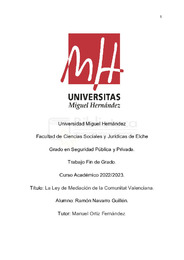Por favor, use este identificador para citar o enlazar este ítem:
https://hdl.handle.net/11000/30440Registro completo de metadatos
| Campo DC | Valor | Lengua/Idioma |
|---|---|---|
| dc.contributor.advisor | Ortiz Fernández, Manuel | - |
| dc.contributor.author | Navarro Guillén, Ramón | - |
| dc.contributor.other | Departamentos de la UMH::Ciencia Jurídica | es_ES |
| dc.date.accessioned | 2024-01-08T15:55:26Z | - |
| dc.date.available | 2024-01-08T15:55:26Z | - |
| dc.date.created | 2023-06 | - |
| dc.identifier.uri | https://hdl.handle.net/11000/30440 | - |
| dc.description.abstract | En el presente trabajo se analiza la mediación, como medio extrajudicial y autocompositivo de resolución de conflictos donde las partes implicadas intentan llegar a un acuerdo con la ayuda del mediador, quien colabora en acercar posturas y que se genere una negociación. En este sentido, llevaremos a cabo un estudio de la normativa (en especial, de la legislación de la Comunitat Valenciana) y abordaremos las principales cuestiones que surgen de esta institución. Asimismo, dicho análisis se acompañará de la doctrina científica más relevante sobre la materia. A este respecto, consideramos fundamental partir de una conceptualización de la mediación y de su diferenciación con respecto a otras figuras afines (como el arbitraje o la conciliación), trataremos de plasmar sus características básicas, el procedimiento a llevar a cabo, así como las ventajas e inconvenientes que se derivan de la misma. Cabe destacar que, en último lugar, dedicaremos una parte del trabajo a la mediación policial, ya que entendemos que es fundamental en este ámbito. | es_ES |
| dc.description.abstract | In the present work, mediation is analyzed as an extrajudicial and self-composed means of conflict resolution where the parties involved try to reach an agreement with the help of the mediator, who collaborates in bringing positions closer and generating a negotiation. In this sense, we will carry out a study of the regulations (especially, the legislation of the Valencian Community) and we will address the main issues that arise from this institution. Likewise, said analysis will be accompanied by the most relevant scientific doctrine on the subject. In this regard, we consider it essential to start from a conceptualization of mediation and its differentiation with respect to other related figures (such as arbitration or conciliation), we will try to capture its basic characteristics, the procedure to be carried out, as well as the advantages and inconveniences that derive from it. It should be noted that, lastly, we will dedicate a part of the work to police mediation, since we understand that it is essential in this area | es_ES |
| dc.format | application/pdf | es_ES |
| dc.format.extent | 33 | es_ES |
| dc.language.iso | spa | es_ES |
| dc.publisher | Universidad Miguel Hernández de Elche | es_ES |
| dc.rights | info:eu-repo/semantics/openAccess | es_ES |
| dc.rights | Attribution-NonCommercial-NoDerivatives 4.0 Internacional | * |
| dc.rights.uri | http://creativecommons.org/licenses/by-nc-nd/4.0/ | * |
| dc.subject | Comunitat Valenciana | es_ES |
| dc.subject | conflicto | es_ES |
| dc.subject | extrajudicial | es_ES |
| dc.subject | mediación | es_ES |
| dc.subject | resolución | es_ES |
| dc.subject.other | CDU::3 - Ciencias sociales::34 - Derecho::343 - Derecho penal. Delitos | es_ES |
| dc.title | La Ley de Mediación de la Comunitat Valenciana | es_ES |
| dc.type | info:eu-repo/semantics/bachelorThesis | es_ES |

Ver/Abrir:
TFG_NAVARRO_GUILLÉN_RAMÓN.pdf
625,43 kB
Adobe PDF
Compartir:
 La licencia se describe como: Atribución-NonComercial-NoDerivada 4.0 Internacional.
La licencia se describe como: Atribución-NonComercial-NoDerivada 4.0 Internacional.
.png)